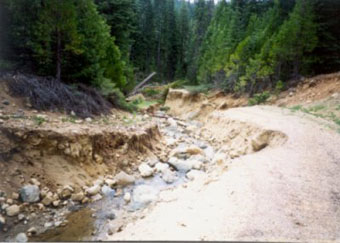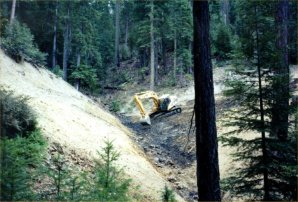

| |
| Search all USDA |
|
Road Decommisioning
Carolyn Napper, Soils Scientist
Introduction Forest road decommissioning techniques are a key tool in effective watershed restoration. Land managers have been involved in road decommissioning over the past three decades, yet there is little consistency in road decommissioning monitoring. This document provides tools for developing and implementing a monitoring plan based on the specific needs and unique ecological conditions of each forest. Several national forests have developed road decommissioning monitoring plans. This report builds on their hard work and careful thought to creating a successful monitoring plan. Instead of advocating one method or process for each monitoring project and budget, this document enables selection of the monitoring technique(s) for each situation. Monitoring forms and protocols are attached that can help a district or forest interdisciplinary team design a road decommissioning monitoring program for their area. In the late 1970s, Redwood National Park (RNP) started to decommission unneeded roads. Park geologists tried to reduce the adverse environmental effects of roads and road crossings including erosion, mass wasting, and sedimentation. Techniques to decommission roads evolved over time as the effectiveness of the treatments was monitored. Treatments changed from hand tools and revegetation to dozers and excavators. The same equipment that created the road was used to decommission the road. At the same time, national forests across the country had the same problems and road decommissioning started. Flood events that occurred during the 1980s and 1990s brought to light the vulnerability of the transportation system and the adverse impacts that result from poorly designed and located roads.
Road decommissioning is used to reduce chronic sediment delivery, restore hillslope hydrology, and reduce impacts to aquatic, riparian, and terrestrial ecosystems of roads crossings. The United States Department of Agriculture (USDA) Forest Service units use different levels of decommissioning treatments to reduce hazards with roads. USDA Forest Service personnel have learned which decommissioning treatments are effective based on local climatic conditions, geology, and soil type. Forest interdisciplinary teams are responsible for developing monitoring plans that can evaluate the effectiveness of decommissioning treatments.
|
|


